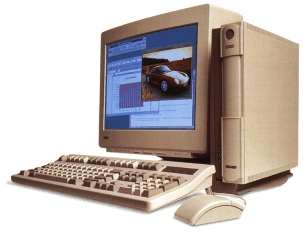
CPU: DEC 64bit Alpha/AXP 21066 @ 166MHz or 21066A @ 233MHz, Intel Pentium @ 100MHz
Video: 2MB Digital 21030 TGA Graphics Adapter
Max Ram: 128MB
chassis: slimline desktop (tower-mountable)
bus: 2x PCMCIA, 1x PCI
Menu:

The Multia, later rebranded the Universal Desktop Box was a line of computer workstations
produced by Digital Equipment Corporation offered with either an Alpha/AXP or an Intel IA32 Pentium processor.
Most of the hardware except the backplane is interchangable. Both the Alpha and the Intel versions
were designed to run Windows NT.

The Alpha Multias included either an Alpha AXP 21066 or 21066A microprocessor running at either 166MHz or
233MHz respectively. They came standard with 16 or 24 MB of RAM (expandable to 128MB). Because the 21066
is a cutdown 21064 these CPUs perform about the same as a Pentium. Graphics are provided by a TGA
(DEC 21030) graphics adapter.
Standard on both Intel and Alpha models are a SCSI Controller, a DEC 21040 Ethernet controller, two PCMCIA
slots, two RS232 ports, a bi-directional parallel port, a 2.5" or 3.5" ATA hard disk (340MB to 1.6GB), PS/2
keyboard and mouse ports, and a PCI slot (on models with a 2.5" hard disk; the 3.5" drive goes in the PCI
slot).
To save space and cut costs the multia was mostly built using laptop technology. The use of laptop components
is the machines major failure point - overheating components that arent built to run 24/7 when
workstations are usually run this way.
Multias were avaialble in the following models: